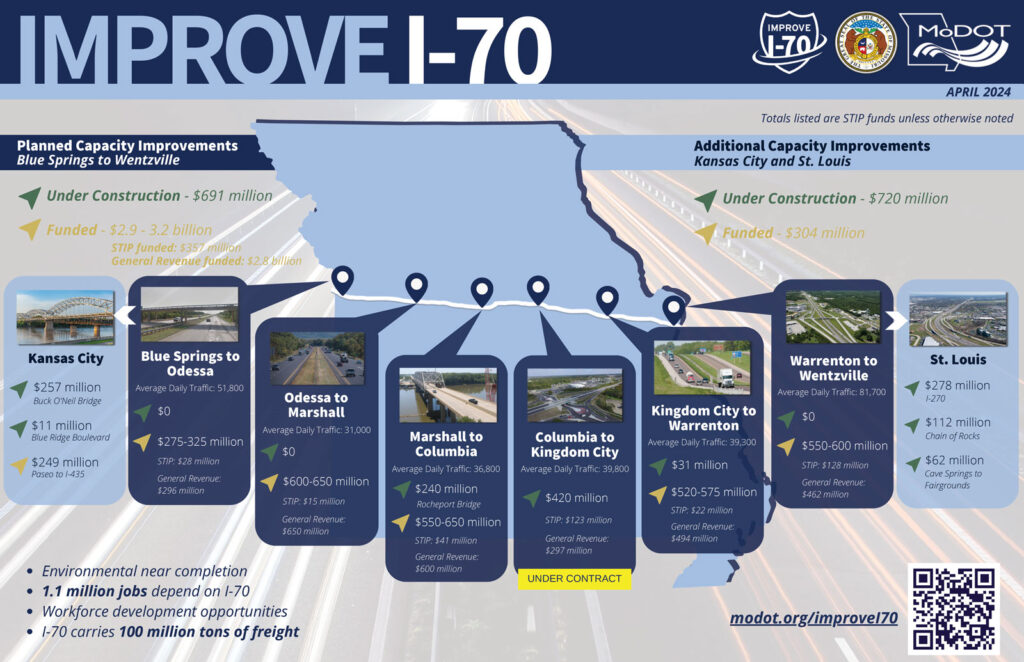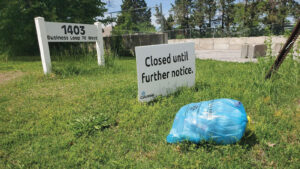Missouri’s most important corridor is getting a long-awaited makeover.
Get ready to see orange safety cones designating work along Interstate 70 for the next few years. And Columbia drivers who loathe roundabouts will need to hone their skills on those traffic installations, which will be major elements of a $405 million project that includes replacing the beleaguered Highway 63/I-70 connector.
Some have referred to the often-jammed connector as “spaghetti junction.” Other pejoratives are more colorful if not bleep-worthy.
The Missouri Department of Transportation (MoDOT) has launched the “Improve I-70 Project,” and the first part of the long-awaited program concentrates on improvements for the twenty-mile stretch of I- 70 between U.S. 63 in Columbia and U.S. 54 in Kingdom City. This summer, MoDOT contractors will begin building a third lane on the interstate in each direction.
The $405 million project is the first of several projects which will widen and improve the I-70 corridor. It’s part of the $2.8 billion Missouri lawmakers approved to expand I-70 to six lanes — with an additional lane to the westbound and eastbound directions — across the state, a stretch of nearly 200 miles from Blue Springs to Wentzville.
“It’s massive,” says Columbia Chamber of Commerce President Matt McCormick. “The 70/63 corridor is probably one of the most important traffic corridors in the state. And this is probably one of the most important projects we’ve had in the state.”
The recent replacement of the Missouri River bridge across I-70 at Rocheport was the first if not unofficial part of the I-70 improvement project.
MoDOT and local transportation officials, as well as business and economic development leaders, have described I-70 as a vital transportation corridor in Missouri, connecting the state’s two largest cities and carrying more rural daily traffic than any other route in the state. The 250 miles of I-70 through Missouri have long been seen as an engine for economic growth.
Missouri marks the distinction of being the birthplace to the interstate with the first interstate project under construction on I-70 in St Charles County between Fifth Street and Route 94/First Capitol Drive. That project broke ground on Aug. 13, 1956. However, being the first also makes it the oldest.
The first contract MoDOT awarded in April was to Millstone Weber for construction and Jacobs Engineering. The 70/63 connector makeover and the twenty-mile stretch from Columbia to Kingdom City is expected to be finished by the end of 2027. MoDOT expects the entire I-70 project will be completed by the end of 2030. The next sections to be contracted will be from Blue Springs to Odessa in western Missouri and from Wentzville to Warrenton on the eastern side of the state.
Lawmakers in 2023 appropriated $2.8 billion — half from surplus general revenue and half from bonds to be issued as needed — for the biggest interstate construction program since the highways were first built in the 1950s and early 1960s. Widening and rebuilding I-70, the first interstate highway to be built in the nation, has been on MoDOT’s unfunded agenda for almost 20 years.
“We’ve been studying this corridor for decades,” MoDOT Director Patrick McKenna said in a news conference when the first contracts were announced.
The section from U.S. Highway 63 in Columbia to U.S. Highway 54 at Kingdom City was chosen because other work has already been planned to rebuild both intersections.
“That section really made sense for us to get a quick start and begin construction later this spring or early summer,” said Eric Kopinski, director of the Improve I-70 Program. “Had we looked at a larger section or incorporated a larger contract, our start would have been much delayed.”
The Columbia intersection of Highway 63 and I-70 is notoriously congested. The makeover and reconstruction plan calls for redirecting as much as 60 percent of local traffic away from the rebuilt interchange.

The overall goal of the Improve I-70 project across Missouri, according to MoDOT, is “to provide a safe, efficient, environmentally sound and cost-effective transportation facility that responds to corridor needs as well as expectations of a national interstate.”
Specifically, the multi-phased project will focus on the following:
- Provide a third lane of travel to eastbound and westbound I-70 from Blue Springs to Wentzville.
- Improve the interstate while modernizing the existing pavement and bridges.
- Increase the efficiency of freight movements along I-70.
- Minimize construction impacts with a focus on work zone safety, communication, and construction staging.
- Expand a diverse workforce through the creation of jobs.
Local and state leaders have also called the I-70 project “a generational opportunity” and “a once in a lifetime investment.”
“This is a major challenge to deliver, but our MoDOT team working alongside the private sector partners in engineering and construction will deliver,” said Terry Ecker, chairman of the Missouri Highways and Transportation Commission.
McCormick said the plan to keep traffic flowing throughout the project was a bonus that should minimize delays for motorists. Two lanes will be open for traffic in both directions across the state throughout the project.
“We promise we are not going to do anything to make people’s lives miserable,” said Thom Kuhn, president of Millstone Weber.
Columbia’s connector will be replaced with four roundabouts, a new bridge, and a new collector road. Project director Jeff Gander said some of the terminology might not be familiar to all motorists, “but it’s really cool and it’s going to work really well.” He added, “It’s going to be like nothing you’ve ever seen, but it is going to function very well.”
Functionality was never in question, but local leaders wanted to challenge MoDOT to go a step beyond and create an attractive, welcoming intersection for 70 and 63.
A group of local business owners that involved Chamber leadership mustered ideas and support for beautifying the new interchange with stonework, plants and trees, and other elements that match Columbia’s landscape and skyline. Some $3 million is included in that part of the project.
“MoDOT does great work, and their projects are always functional, but not always aesthetically appealing,” McCormick said, noting that he was being careful not to denigrate MoDOT’s lengthy history of development alongside Columbia. “This is a once in a generational opportunity to really upgrade the aesthetics.”
McCormick added that Columbia can be proud of its place in the state’s transportation system, and that getting the 63/70 connector on the state’s revenue and budget radar “opened the door for all of I-70” to be improved.
Based on decades of MoDOT and city cooperation, McCormick said it seems fitting that the cross state I-70 project will be completed in multiple phases, with Columbia serving as “reverse bookends.” The project starts with the stretch from Columbia to Kingdom City and will end with I-70 improvements from around Boonville to Columbia.
“It starts and finishes in Columbia,” he explained.
McCormick said he is eager to see the fruits of the project’s “very aggressive timeline” and the six-year, phased approach that will help keep the workforce stable.
Bob Leingang, vice president and chief engineer of Millstone Weber, said in a news release that the timeline is deliberate.
“This is a huge deal for everyone who drives this stretch of interstate and uses these interchanges,” he added. “We will do everything in our power — and then some — to reward the confidence being shown in us to deliver this critical project.”
MoDOT hosted public meetings in Columbia and Kingdom City in early May to share plans about the project, and answer questions. MoDOT will follow that pattern before construction gets underway on other sections of the project.




COMO’s Main Corridor: From Stagecoaches to Semis
Once upon a time, horses, wagons, and then stagecoaches were the main mode of transportation through central Missouri. More than a century before I-70 was even conceived — and Missouri was a brand-new state — the main thoroughfare linking Columbia with the rest of the 24th state in the union was the Boonslick Road.
Originally located about seven miles north of Columbia, in 1822 the Boonslick Road was relocated to pass through Columbia on what is now Broadway, making Columbia the retail center for an extended trade area.
That bit of history comes from former Columbia City Manager Ray Beck, who wrote in August 2006 — just six months after retiring from a 46-year career with the city — that the corridor “is still the economic hub of our region today” and that, “Columbia soon became the halfway point stop for stagecoaches traveling between Kansas City and St. Louis.”
The original U.S. Highway 40 also passed along Broadway through the center of Columbia’s business district until it was relocated several blocks north of Broadway to what was then the urban fringe. (That roadway is now called Business Loop 70.)
In 1948, Highway 40 was widened and resurfaced, and even after I-70 was under construction a decade later, Highway 40 was again widened, and a median was installed to reduce accidents. This improvement by the Missouri Highway Department generated substantial local debate, Beck wrote 18 years ago for an article in the Columbia Business Times.
After the new Interstate Highway System was approved by Congress in 1956, Columbia’s portion of the new I-70 was one of the first out-state segments to be built. It consisted of 7.3 miles of dual-lane limited access highway beginning near what was then called Conley Lane eastward to about 2.6 miles east of the city limits.
“It was considered a bypass at the time, but you’d never know it now. Over time, the city grew and enveloped the highway, making it necessary today to improve the highway, create a new bypass, or both,” he wrote.
Construction began in the summer of 1957, and I-70 was opened to traffic in 1958. He added, “By today’s rules, the interchanges are spaced too closely together, so more interchanges were approved for Columbia than would ever be approved today, but I believe the extra exits have been a real plus for our city. Five interchanges were constructed within the city limits, with the Conley Lane interchange on the west the last one built.” Conley Lane later became Stadium Boulevard, a major expressway from I-70 to Highway 63, which he recommended should be continued eastward to meet I-70.
Beck’s article in 2006 now seems prophetic. The article concluded thusly.
“One good alternative for MoDOT to consider, for financial reasons, would be to widen I-70 to three lanes through Columbia in each direction and redesign interchanges with an outer roadway system that might be good for about 20 years.
Regardless of the choice made, the same dance will continue, as it has throughout our history, whether you call the main highway the Boonslick Trail or the new Interstate 70. Travelers want to move through to their destination, and businesses try to entice them to stop and spend their money. It is important that the stagecoach still stops in our city.”









